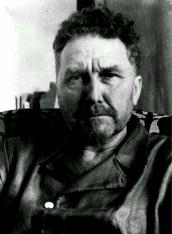Ezra Pound
 Ezra Pound was one of the most influential American poets of this
century. From 1908 to 1920, he resided in London, where he
associated with many writers, including William Butler Yeats, for
whom he worked as a secretary, and T.S. Eliot, whose Waste
Land
he drastically edited and improved. He was a link between the
United States and Britain, acting as contributing editor to
Harriet Monroe's important Chicago magazine Poetry and
spearheading the new school of poetry known as Imagism, which
advocated a clear, highly visual presentation. After Imagism, he
championed various poetic approaches. He eventually moved to
Italy, where he became caught up in Italian Fascism.
Ezra Pound was one of the most influential American poets of this
century. From 1908 to 1920, he resided in London, where he
associated with many writers, including William Butler Yeats, for
whom he worked as a secretary, and T.S. Eliot, whose Waste
Land
he drastically edited and improved. He was a link between the
United States and Britain, acting as contributing editor to
Harriet Monroe's important Chicago magazine Poetry and
spearheading the new school of poetry known as Imagism, which
advocated a clear, highly visual presentation. After Imagism, he
championed various poetic approaches. He eventually moved to
Italy, where he became caught up in Italian Fascism.
Pound furthered Imagism in letters, essays, and an anthology. In a letter to Monroe in 1915, he argues for a modern-sounding, visual poetry that avoids "clichés and set phrases." In "A Few Don'ts of an Imagiste" (1913), he defined "image" as something that "presents an intellectual and emotional complex in an instant of time." Pound's 1914 anthology of 10 poets, Des Imagistes, offered examples of Imagist poetry by outstanding poets, including William Carlos Williams, H.D. (Hilda Doolittle), and Amy Lowell.
Pound's interests and reading were universal. His adaptations and brilliant, if sometimes flawed, translations introduced new literary possibilities from many cultures to modern writers. His life-work was The Cantos, which he wrote and published until his death. They contain brilliant passages, but their allusions to works of literature and art from many eras and cultures make them difficult. Pound's poetry is best known for its clear, visual images, fresh rhythms, and muscular, intelligent, unusual lines, such as, in Canto LXXXI, "The ant's a centaur in his dragon world," or in poems inspired by Japanese haiku, such as "In a Station of the Metro" (1916):
Petals on a wet, black bough.
